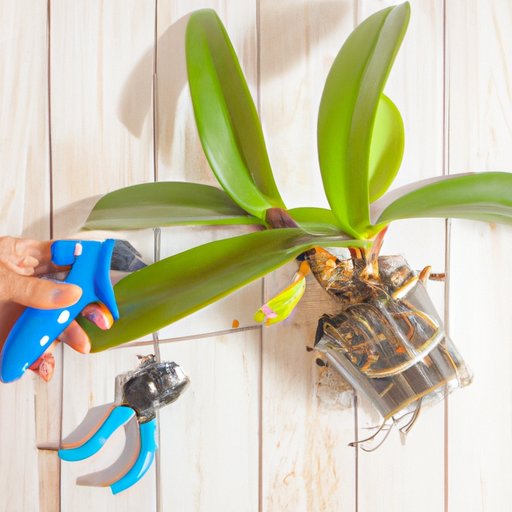
I. Introduction
Orchids are a delicate and beautiful plant that require special care to thrive. In this article, we’ll guide you through the process of taking care of your orchids, from choosing the right pot and soil to dealing with pests and diseases. With a little bit of knowledge and attention, you can create an environment where your orchids will flourish for years to come.
II. Start with the Basics
The conditions that orchids need to grow properly are somewhat different from what most other plants require. The ideal growing conditions for orchids are bright but indirect light, plenty of humidity, and a temperature between 65 and 80 degrees. It’s important to allow air to circulate around the plant, so proper ventilation is crucial to their well-being.
III. Choose the Right Pot and Soil
When it comes to choosing a pot and soil for your orchids, there are a few things to keep in mind. Orchids need a well-drained potting mix to keep their roots from rotting. A clear plastic pot will allow you to see the roots and monitor their health. Look for potting mediums that include a mixture of bark, sphagnum moss, and perlite or vermiculite.
IV. Watering Tips
Knowing how often to water an orchid can be tricky. Generally, orchids prefer to dry out slightly between waterings. You can tell if your orchid needs water by feeling the soil mix. If it’s dry an inch deep or the pot feels light, it’s time to water. Be careful not to overwater, as this can cause root rot.
V. Fertilization
It’s important to fertilize your orchids to keep them healthy and promote blooming. However, using the wrong type of fertilizer can be harmful. Choose a balanced orchid fertilizer that contains nitrogen, phosphorus, and potassium. Fertilize once a month when the plant is actively growing, and adjust the frequency as needed. Be careful not to over-fertilize, as this can cause damage to the plant.
VI. Pruning and Repotting
Pruning is necessary to keep your orchid healthy and looking its best. Remove flower spikes once they are spent, and trim any yellow or brown leaves or stems. Repotting is necessary when the potting medium is broken down and no longer draining well, or the plant has outgrown its pot. Use a fresh potting mix and be gentle during the repotting process, as orchids don’t like their roots disturbed.
VII. Pests and Diseases
Keeping your orchids free of pests and diseases is essential to their health. Common pests that affect orchids include scale insects and spider mites. Use an environmentally friendly insecticide to treat these pests. Fungal infections can also be a problem. Overwatering can cause root rot, which can quickly spread to the rest of the plant. If you notice signs of disease, take action immediately to prevent it from spreading.
VIII. Trouble-Shooting Random Issues
If your orchids aren’t blooming, it could be due to a lack of light, improper fertilization, or other factors such as a sudden change in temperature or humidity. Check all growing conditions, including light intensity, temperature, and humidity, and adjust as needed. If the leaves are turning brown, it could be an indication of overwatering, underwatering, or too much direct sunlight. Evaluate your watering and light schedule and make appropriate changes to correct the issue.
IX. Conclusion
Orchids can be a beautiful addition to your home or office, and with proper care, they can thrive for years. Remember to pay attention to growing conditions, use the right potting mix and fertilizer, and keep your plants free of pests and diseases. With these tips and a little bit of attention, you can enjoy beautiful, healthy orchids for years to come.





